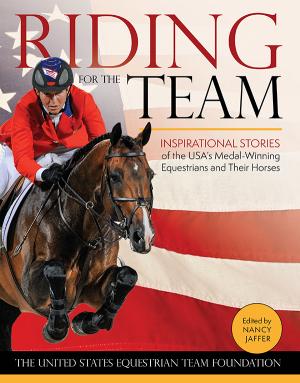Review by Nancy Brannon
Due to the COVID-19 outbreak, the 2020 Olympic Games were postponed for the first time in their history, re-scheduled for July 23 – August 8, 2021 in Tokyo, Japan. Since folks will not be participating in and watching the Olympic Games this summer, perhaps the next best thing is reading about the lives of those who dreamed about competing for their country and “made it” in Nancy Jaffer’s latest book Riding for the Team. She has compiled inspirational stories from the eight Olympic level equestrian disciplines: show jumping, dressage, eventing, driving, vaulting, reining, endurance, and para-dressage. In conjunction with the United States Equestrian Team, this book gives you behind the scenes details of those who lived the culmination of an equestrian career – Riding for the U.S. Equestrian Team.
This 302-page coffee table style book features the stories of 47 athletes who have ridden on championship teams for the U.S. in all eight international equestrian disciplines. These stories are told by the athletes who became a part of equestrian history, sharing their love and appreciation of their special horses who took them to the top in the Olympics, World Equestrian Games, World Championships, and Pan American Games.
Readers are immersed in the fascinating histories of the medal-winning riders, drivers, and vaulters who have dominated American equestrian sport over the past 28 years, such as McLain Ward, Karen O’Connor, Debbie McDonald, and Tim McQuay. Get the inside scoop on legendary horses who have become household names, including Flexible, Biko, Verdades, and Gunners Special Nite. The text is beautifully illustrated with breathtaking photographs from prestigious competitions held around the world.
This book is a sequel to Riding for America, which Jaffer compiled and published in 1990. Jaffer’s first book on this equestrian theme was the U.S. Equestrian Team Book of Riding, which marked the organization’s 25th anniversary in 1975.
In most sections, readers will find special people and/or horses to identify with, and most of those riders profiled extol the brilliance of the horse(s) they have ridden.
The book begins with Show Jumping, the most popular of Olympic Equestrian sports, and with stories by Beezie Madden, McClain Ward, Margie Goldstein Engle, Kent Farrington, and more. Throughout the book you’ll find that many top riders in various disciplines started out in Pony Club. Kent Farrington writes, “After joining Pony Club, I got involved in pony racing… My mother traded three used computers for my first horse, MVP No. 4.”
People in west Tennessee will find interest in Laura Kraut’s story: “It All Started with Simba Run.” She writes: “One summer day in 1990, we were at a show in Germantown, Tennessee, where it was 105 blistering degrees. Geoff Sutton, who was the owner/rider of an interesting Thoroughbred show jumper, Simba Run, said to me, ‘I can’t deal with this heat. Would you ride my horse?’” Geoff owned a barn in “old town” Cordova, Tennessee and many readers will remember watching Geoff show this horse. But did you also know that Jason Schnelle, owner/trainer at Autumn Chase Farm, south of Collierville, Tenn., went to work for Kraut in 1992, just prior to her trip to the 1992 Olympics with Simba Run. [see my Mid-South Horse Review article on Autumn Chase Farm, Sept. 2009]
In his narrative, Chris Kappler draws similarities between the U.S. gold medal show jumping team at Athens in 2004 and the 1984 Los Angeles gold medal team: “Touch of Class with Joe Fargis, who won individual gold Abdullah, Conrad Homfeld’s individual silver medal ride; Calypso, the longtime mount of Melanie Smith (of Germantown, Tenn.), and Albany, ridden by Leslie Burr.”
Next is the Dressage section starting with Laura Graves and Verdades, aka “Diddy.” Here you’ll learn how this “rough-looking foal” who “was so green that he hadn’t even worn a halter until he was imported” was brought along by Graves to become the super horse who enjoyed being the star of the dressage arena. Graves herself had “horrible nerves” about showing, but when she took Diddy into the arena at Wellington, “it was as if he had been doing this all his life. He seemed to realize, ‘Hey this is cool, all these people, all these carrots.’” Laura is humble about her equestrian beginnings: “I was the kid who couldn’t afford, who couldn’t do, who couldn’t have …The best advice I can give is to learn how to succeed at failing.”
Dressage fans will remember Debbie McDonald and Brentina, dressage stars from 1999 – 2006. Brentina’s style and willing attitude always put a smile on Debbie’s face.
Steffen Peters is a pillar of U.S. Dressage, who is best known for his relationship with Ravel, the USEF’s Horse of the Year in 2009, and over his career, had more than 40 Grand Prix wins and was inducted into the U.S. Dressage Federation Hall of Fame. Lately, Peters’ partnerships with Legolas (earning 77% in the Grand Prix at the 2016 Rio Olympics) and Suppenkasper (silver medal at the 2018 FEI World Equestrian Games in Tryon, NC), have wowed crowds around the world.
Guenter Seidel started his international career with Graf George and later earned the bronze medal at the 2004 Olympics and 2006 WEG with former show jumper Aragon.
Carol Lavell and Gifted were an inspired match, with Gifted honored as USDF Horse of the Year at Grand Prix in 1991. The highlight of Gifted’s career was at the 1992 Barcelona Olympic Games where the U.S. earned a bronze medal.
Three-Day Eventing is one of the most exciting equestrian sports, with record crowds flocking to the Kentucky Three-Day Event every year, except 2020. But did you know that women were not allowed to compete in Olympic eventing until 1964 when American Lana du Pont was the first and contributed to her team’s silver medal? Riders in this section talk about how their sport has evolved and changed over the years, with its origins in the cavalry. Eliminating the roads and tracks and steeplechase portions has also changed the horse breed preferences for competitors, moving from Thoroughbreds to Warmbloods.
This section covers such eventing stars as Phillip Dutton, Boyd Martin, David and Karen O’Connor, and Kim Severson.
Boyd Martin writes that he “went to Pony Club every Sunday” as he was growing up. There’s a tragic tale of a barn fire and how he rushed into the barn to save his horse Neville. Martin writes, “What I’ve learned is that to succeed in this game, you need a good strong team around you…to get from goals to achievements, you need hard work and discipline.”
Karen O’Connor’s story covers “the tall and the short of it,” from Biko, her 17.3-hand Thoroughbred who was the eventing Horse of the Century and won team silver at the 1996 Atlanta Olympics, to “the valiant 14.1-hand pony Theodore O’Connor.” Karen describes how “Teddy,” a Thoroughbred (going back to Bold Ruler), Arabian, and Shetland Pony cross came to her. At five feet six inches tall, Karen had to shorten her stirrups to ride him. But “not only could he do a four-star, he did it as easily as any horse I’ve ever ridden.”
At the 2007 Kentucky Three-Day Event, Karen had a humorous exchange with British Olympic medalist Ian Stark. As she was riding Teddy to the main arena, Stark called out, “Hey, O’Connor, the Prince William Games are in the other arena,” referring to the U.S. Pony Club gymkhana games for kids on their ponies. Her response: “Get a good look at this (pointing to Teddy’s hindquarters), because that’s what you’ll be seeing going into the prize giving.” Sure enough, Karen finished third and Stark was eleventh.
Kim Severson’s most famous mount, Winsome Adante, (aka Dan) won the Kentucky four-star event three times. She, too, was involved with Pony Club. She writes, “It was his heart and our confidence in each other that made our partnership successful….He was a once-in-a-lifetime horse.”
Gina Miles, another eventing star, grew up in Pony Club, “riding anything I could find.”
Derek Di Grazia is now best known as an Olympic and Kentucky Three-Day event cross country course designer. But did you know that he won the 1985 Kentucky Three-Day CCI five-star on Sasquatch, an Appaloosa/Thoroughbred cross? Those interested in course design will find his explanations of the all the considerations that go into to making successful cross county courses very informative.
Kerry Millikin, also with beginnings in U.S. Pony Club, writes that “riding on the U.S. team is an honor that comes with a big responsibility”…beginning with “a lifetime of dedication and hard work.” Learning from Deepak Chopra’s Seven Spiritual Laws of Success, she writes, “It’s now what happens to us that matters, but what we do with what happens to us.” Did you know that Millikin also creates horse sculptures?
Combined Driving was invented by Great Britain’s Prince Philip, designed along the lines of three day eventing, with a dressage phase, marathon phase (cross country), and a cones phase. The best known U.S. competitor in Combined Driving is Chester Weber. While nearly all the other equestrians talk about their horses, their mentors, what they have learned, and their appreciation for the unique opportunities they have had, Weber primarily talks about getting sponsors for financial support. For years he worked with Jane Clark, when “we always had a strategic plan every year, with clear goals of how we would define success. We did our best in terms of horsemanship to allow the horses to be prepared for those goals.” Weber said he always kept in mind, “I’m doing this to be successful and to win.”
I had the opportunity to meet Jimmy Fairclough in person when the Carriage Association of America brought their annual conference to Germantown, Tenn. in September 2019. Jimmy has participated in more World Championships than any other U.S. driver. He writes, “I have learned so much from my involvement with driving…It reinforced my work ethic and commitment, teaching me that if you want to succeed, you had to work at it continuously. It’s commitment, dedication, and perfection – all of that together.”
Suzy Stafford was the first U.S. driver to win an individual gold medal in a World Championship. Suzy was also a Pony Clubber who later became an event rider. “When I was an event rider, I believed driving was a sport for old people.” But she explains how she got into driving ponies, and the “catch drive” of Sybil Humphrey’s Cefnoaks Bouncer, a 13.2-hand Welsh Cob, that earned her a gold medal. Her latest international success was with PVF Peace of Mind (Hunny), USEF’s International Horse of the Year in 2015. He even got his picture on the Triple Crown feed bag and was named a Breyer model horse.
Readers may not be as familiar with the stars of Para-Dressage as with the other disciplines. In fact, “para” refers to being parallel to able-bodied sport, not paralyzed or paraplegic. In 2006, para sport joined the ranks of the other disciplines regulated by the FEI.
Vicki Garner-Sweigart was the pioneer in the sport, bringing home two gold medals for the U.S. at the first Paralympics equestrian competition at the 1996 Games in Atlanta. At that time, the sport was structured like IHSA, in which riders had to draw their horses from a pool of horses for competition and had to adjust to the horse in a short period of time before competing. Her story focuses on getting a draw of the “best horse in Atlanta – Miss Jane Marple. I believe whoever rode her would have gotten a gold medal.”
Lynn Seidemann began her para competition with basketball, and then in wheelchair tennis at the Paralympic Gamers in 1992, where she won team silver. A snow skiing accident in 1983 had left her with no function from the navel down. But she found that “riding helps strengthen the abdominal muscles” and that competing gave her “the goal to keep in better shape and to make the effort to be the best you can. …It helps your mind and soul to use your body. Riding felt as if I were walking again.” She, too, rode Miss Jane Marple to compete in the qualifiers for the 2000 Sydney Paralympics in Australia. “I love horse people; the passion for their animals and that partnership is really great. I felt like I was whole again when I rode.” She is grateful for these opportunities that “have made me evolve as a better person.”
Kate Shoemaker and Roxie Trunnell were medal-winning members of the U.S. Para-Equestrian Dressage Team at the 2018 FEI World Equestrian Games. Kate, an equine veterinarian, loaned her horse Dolton to Roxie for WEG. Dolton was only 6, the youngest age at which a horse is eligible for para competition. But he and Roxie won the bronze medal in the FEI Grade I Freestyle with a score of 75.487%! Both had great praise for Dolton. “I’ve never had a horse so bonded to me,” wrote Kate. Roxie wrote of him, “His personality is very goofy. You can tell he is a young horse by the way he acts on the ground. But when you get in the saddle, he is very much all business and acts far older than his years.”
Rebecca Hart won a silver medal with an impressive score of 73.240% in the Grade III Freestyle at the 2018 WEG. To help Becca buy her first international horse, her parents mortgaged their house, when they were only a couple of payments away from owning their home outright. Becca learned, “In equestrian, there is a silent communication that is universal and standard classical, but within that, each horse has its own dialect. That’s what I was able to finesse, each horse’s dialect.”
Reining is a relative newcomer to FEI sports, first appearing in 2002 at the WEG, but has been recognized as a sport by AQHA since 1949. Readers are probably familiar with “the first family of reining – three generations of the McQuays and the McCutcheons. Just months after graduating from high school, only 18 years old at the 2018 WEG, Cade McCutchen was on the gold medal team and won individual bronze aboard Custom Made Gun. According to Cade’s grandfather, Tim McQuay, “Before he could ride, he would do the patterns on his stick horse.” Tim won team gold and individual silver on Mister Nicadual at the 2006 FEI WEG in Germany. Cade’s dad, Tom McQuay said of Cade’s run at Tryon: “It was the perfect run to promote reining. It was a fat, happy horse on a loose rein; everything was done correctly.”
Another legend in reining is Shawn Flarida, who was on his first gold medal team in Jerez, Spain in 2002, riding San Jo Freckles, a horse he had trained since he was two. Flarida won WEG team gold on RC Fancy Step in 2010 and scored double gold at the 2014 FEI WEG on Spook’s Gotta Whiz.
Flarida writes, “I’ve had a lot of great horses, but one that was very special to me was Wimpy’s Little Step,” who won the National Reining Futurity in 2002. “Being a good horseman makes everything else fit in….I cannot thank my horse enough…” One of Flarida’s favorite things to do when he’s off on Sunday is to get up in the morning and sit in the barn and listen to the horses eat.
The last two disciplines that Jaffe covers are Endurance and Vaulting.
Endurance rider Becky Hart’s story focuses on Rio, “the horse who really made my career. And he didn’t cost a cent.” Her first endurance horse, Khameo, “was a consistent Top 10 horse, but he would always quit 5 or 10 miles from the finish.” Rio was given to her in 1983 and, the first time she rode him in the Tevis Cup, the most demanding Western States Endurance Ride, now only did Rio finish, but he won it on his first try! Rio won his last race at age 21 and had 10,305 miles in competition. His career was one for the record books!
Endurance rider Valerie Kanavy “was the kid who asked for a horse every Christmas and galloped around the yard on a stick horse.” At the 1994 FEI WEG, she was champion with her $500 horse Pieraz.
In Vaulting, Megan Benjamin Guimarin writes about the humble Danish Warmblood, Leonardo, that her family purchased for a bargain price in partnership with Lasse Kristensen, the man who would transform the horse into the best vaulting horse in the world. She also talks about her relationship with “a little gray named Centuro, who was tiny by vaulting standard, standing less than 17 hands tall, and a typical gray, he was always stained brown and green from his romps around the fields.” But with Centuro, “it was instant harmony – his stride and size and shape all seemingly designed just for me. …His confidence triggered my own confidence.”
What’s impressive about these riders is their dedication to their horses and their constant striving to be the best they can be, and to help their horses achieve their best. They are highly organized, disciplined, and very competent horsemen/horsewomen, and so appreciative of their horses.
The book is offered for sale by the USET Foundation, proceeds from which will help support athletes representing the United States of America. Find out more at www.USET.org.









